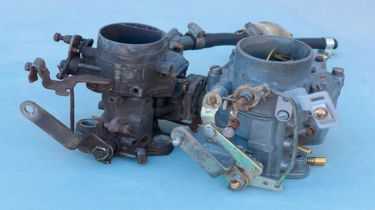What is a carburettor? How they work and what can go wrong.
Carburettors are a common feature in old cars. Here we explain what they are, and how they work

Carburettors or ‘carbs’ haven’t been a regular fixture in cars since the 1990s. They were replaced by fuel injection, which was better at metering out the fuel and air required by an engine, and in recent years the rise of electric vehicles means plenty of cars do without fuel and air entirely.
If you’re looking at buying a retro or classic car though, carburettors are much more common. They’ve been in use since the very first cars, employing a little physics to supply the right mixture of air and fuel (generally 14.7 parts air to one part fuel, which is called the stoichiometric ratio) for ideal combustion in the car’s cylinders. The technology improved over time, as did the means of controlling the air to fuel ratio, but the principle of a Carburettor remained very much the same.
While far from perfect, these devices give older cars a distinct sound, smell, and feel. They’re easy to understand but can get quite complex in certain cars, and since they’re responsible for how a car runs, they can also be responsible for a lot of running problems in older cars.
Below, we explain how a carburettor works, what components make up a typical carburettor, what can go wrong, and what you can do to fix some common issues involving carbs.
How does a carburettor work?
At its basic level a carburettor is beautifully simple. It essentially consists of a narrow passage between two wider ones, and at the centre is a means of admitting fuel.
The narrow passage creates a venturi effect, where air speeds up as it’s forced through a smaller aperture, and as fuel is released into this high-velocity airflow it atomises. The passage then widens again, allowing the mix of air and fuel through a throttle butterfly and into the cylinder, where combustion occurs.
Opening the throttle butterfly is what creates the airflow between the outside world and the cylinder, since the action of the piston going down pulls air through the venturi. When you step hard on the accelerator pedal, a lot more air can flow through, and this, in turn, pulls more fuel through into the cylinder, for more power.

In reality, automotive carburettors are a little more complicated than this basic layout. They tend to include a choke valve before the venturi, which is used to richen the mixture for starting the car (when it’s partly closed, there’s less air for a given amount of fuel), especially in cold weather when fuel doesn’t vaporise as easily.
There’s also a float bowl, which is where fuel is initially drawn in. Inside the bowl is the float, which moves up or down depending on the volume of fuel inside. When the fuel level inside the bowl is sufficient the float moves up with it and closes a valve to prevent too much fuel flowing in, and ensuring that not too much is drawn into the venturi.
And fuel isn’t simply admitted through a hole, but a little needle-like jet, which can be changed if necessary to allow for more or less flow, depending on atmospheric conditions (such as running a car at high altitude). Many carburettors also have a small idle circuit, a tiny air passage that allows a certain volume of air through to keep the engine running when the throttle butterfly is fully closed. A mixture screw can be used to adjust the quantity of fuel flowing through at idle for steady running.
Getting more complex still, some carburettors use an ‘accelerator pump’ to introduce extra fuel when quickly opening the throttle, to account for the sudden extra volume of air this causes.
Then you can have two-stage carburettors, where there are two throttle butterflies, the second opening on larger throttle openings to admit much more air and fuel. There are also twin-choke carburettors, which have two separate passages, each with their own float bowl, jet, and throttle butterflies, which again can admit a higher volume of fuel and air for greater performance.
We should also note that diesel cars, even older ones, don’t use a carburettor. Diesel fuel is injected directly into the cylinder, and is then ignited under compression, rather than by a spark plug. Air flows constantly into the cylinder when the valves open and output is determined by the amount of fuel injected.
What can go wrong with a Carburettor?
Petrol cars need fuel, air, and a spark to run, and the carburettor deals with the first two of these, so a lot of starting problems in old cars are caused by the carburettor.
If your earliest motoring memories started after fuel injection became the norm you may not remember the sounds of a neighbourhood full of starter motors whirring away each morning as cars struggled to start.
Cold weather always made things a little more difficult for carburettors, as fuel doesn’t vaporise as easily when it’s cold (and air rushing through a venturi in a carb gets even colder). As a result, an improperly set choke, to try and richen the mixture for easier starting, could lead to flooding - where too much fuel enters the cylinders and wets the spark plugs, so the engine won’t fire.
If your engine has flooded in this manner (different from literally flooding the engine by driving through deep water!) then reducing the amount of choke, and holding the throttle open while starting may be enough to clear it, pulling mostly air into the cylinder and hopefully flushing excess fuel through the exhaust. In more extreme cases, it may be necessary to pull each spark plug and clean or replace them if they’re too wet to spark.
These problems can be exacerbated if the carburettor is older and in need of maintenance, perhaps allowing too much fuel into the cylinders and running rich, or not enough and running lean, causing problems both on start up and in normal running. Seals in the carburettor can deteriorate and cause leaks, jets can gum up, and floats can get stuck, all of which can cause problems.
Any mechanic familiar with older cars should be able to fix carburettor problems, but if you’re handy with a spanner yourself – or more realistically, a bunch of screwdrivers and pliers - then it’s possible to buy rebuild kits for a lot of old carburettors, with new seals, floats, jets, and other components to refresh the carb. For some carbs, kits like this can cost as little as £20 or so; not a lot of money to have your car running like new again.
While the carb is apart, it’s also a good time to clean out old fuel residue or other deposits to ensure problems don’t resurface when you put it back together and bolt it to the car.
Did you know you can sell your car through Auto Express? We’ll help you get a great price and find a great deal on a new car, too.
Find a car with the experts






